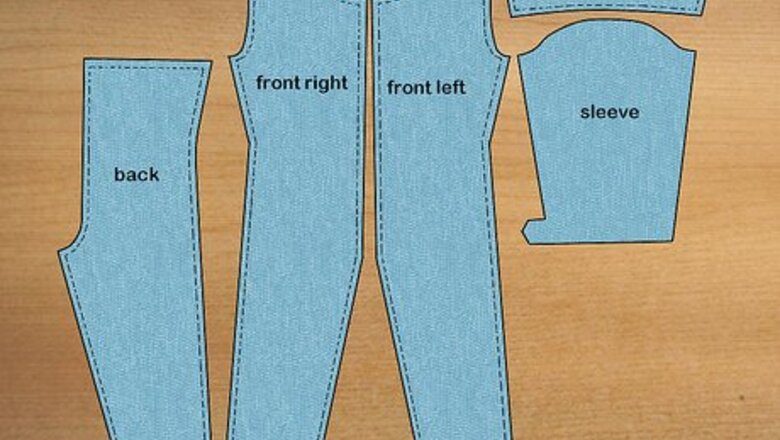
views
Designing Your Overalls
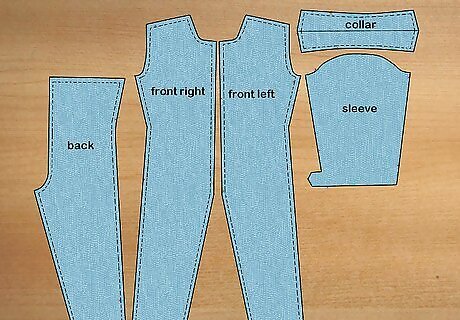
Choose a pattern. Using a pattern to make your overalls is the best way to ensure a good result because making overalls requires some precise pieces. There are many overall patterns available in craft stores and online that you can follow. Patterns range from easy to difficult, so make sure to choose a pattern that is appropriate for your level of sewing skill. Look into vintage patterns if you want your overalls to have a vintage look to them. You can also find patterns that will allow you to make overall shorts or an overall dress if that is what you prefer.
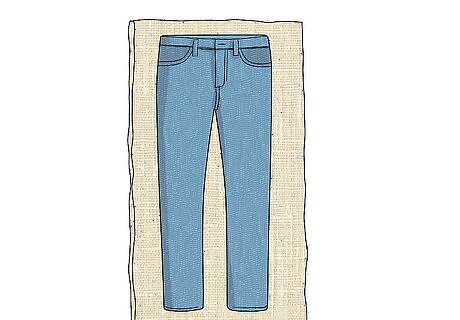
Consider going pattern-free. While using a pattern will give you good results, you can also make a pair of overalls without a pattern if you choose. If you would prefer not to use a pattern, then you can also use an old pair of jeans as a guide for cutting out your fabric pieces for a pair of overalls. Choose a pair of jeans that fit you well.
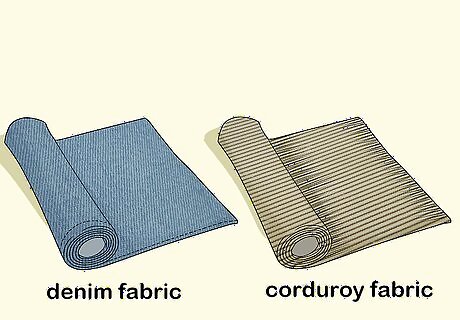
Select your fabric. The fabric you choose for your overalls can change the look dramatically. You can go with a basic denim fabric if you want to create denim overalls, or go with something less conventional, such as corduroy. You are also not limited to heavy weight fabrics when making overalls. You can go with a lightweight cotton fabric or a linen to make a nice summer pair of overalls. Choose your fabric type, texture, and color to make your overalls stylish. Keep in mind that fabrics with a pattern or texture will be more challenging to work with because you will have to pay attention to the direction of the pattern or texture as you work.
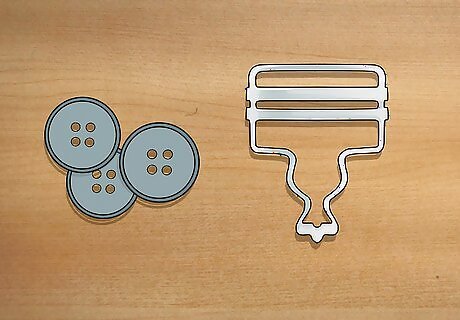
Buy your hardware. The hardware you use to make your overalls will also affect the finished product. You can go with something simple, such as basic brass or silver buttons and buckles, or opt for something a little different, such as a lightweight button that you can sew onto your overalls. Check your local craft store or look online to see what your options are.
Using a Pattern to Cut Out Pieces
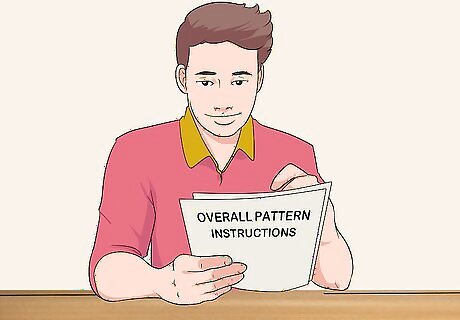
Read your pattern’s instructions. If you are using a pattern, then it is important to read the instructions carefully before you get started. Missing or misunderstanding a step can result in issues with your finished garment. Read through the instructions and make notes of anything that will require special attention, such as where to place the pattern on your fabric when you cut it out or what kind of stitch to use when you sew your pieces together.
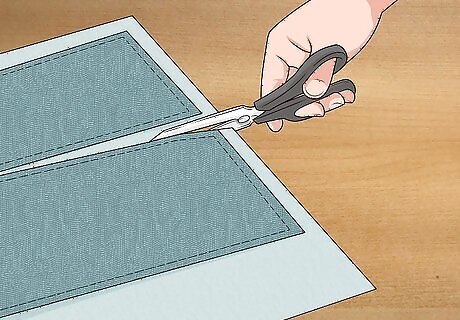
Cut out all of the pattern pieces. Lay out your pattern and then begin cutting out all of the pieces as indicated. Cut along the lines for the size of overalls you will need. Set each pattern piece aside as you go.
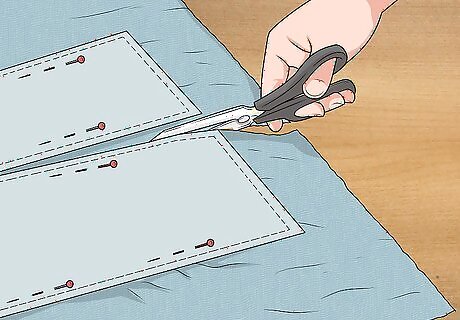
Pin the cutouts to the fabric and cut around the edges. Next, lay out your fabric and begin pinning the paper pattern pieces onto your fabric. Make sure to pay attention to the pattern instructions for pinning because some pieces may need to be pinned to a piece of folded fabric in a certain way. After you have pinned all of your pieces in place, you can begin cutting them out. You may leave the pattern piece pinned onto the fabric pieces to make them easier to identify later, or identify the pieces another way if you prefer, such as by marking the wrong side of the fabric pieces with chalk.
Using a Pair of Jeans to Cut Out Pieces
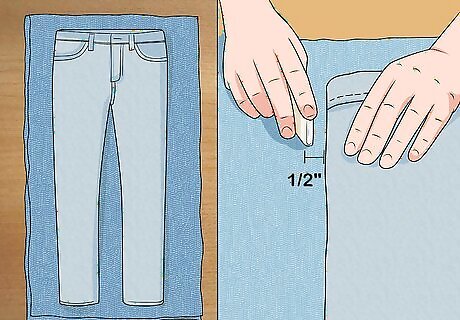
Trace the outline of your jeans onto your folded fabric. Lay out your fabric so that it is in two layers and place your unfolded jeans on top of your fabric. Smooth them out so that they are flat and even. Then, trace around the edges of the jeans leaving about ½” (1.3 cm) on all sides for seam allowance. If you want baggier overalls, then trace further away from the edges of the jeans. For example, you could trace 2” (5cm) from the edges of your jeans for baggy overalls. You might also use a baggy pair of jeans to make it easier to get a loose fit.
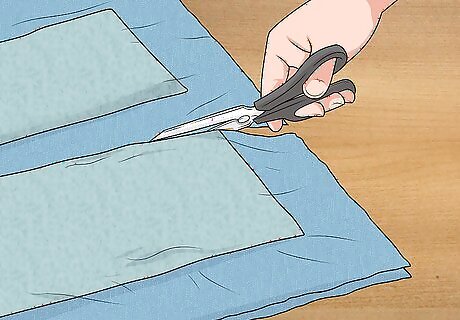
Cut along the lines you traced. After you finish tracing around the edges of your jeans, use a sharp pair of scissors to cut along the edges of the lines you created. Make sure to cut straight even lines in your fabric. The 2 pieces you cut out will be the legs and waistband of your overalls.
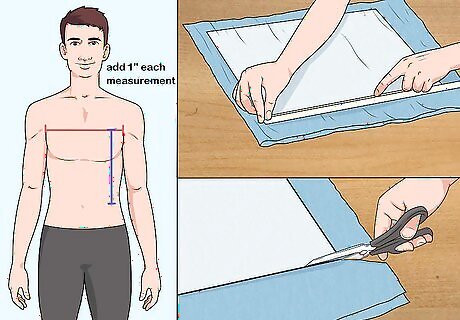
Cut out 2 rectangles large enough to cover your chest and abdomen. Next, you will need to create the bib pieces for your overalls. To do this, measure from your waist to your chest and cross the front of your chest. Then, add 1” (2.5 cm) to each measurement for a seam allowance. Trace a rectangle with these dimensions onto your folded fabric and then cut it out from both layers. These pieces will be the front and back bib pieces for your overalls.
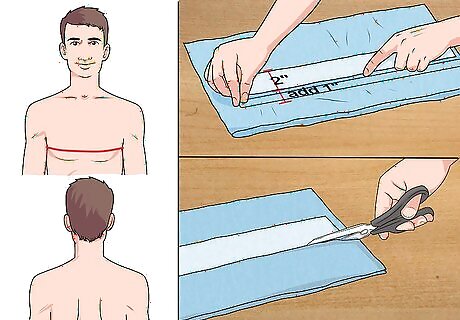
Cut out the straps. To make the straps, measure from your chest to your shoulder blade and add 1” (2.5 cm) for a seam allowance. This will be the strap length that you need to create. You can make your straps as wide or as narrow as you like, but 2” (5 cm) to 3” (7.5 cm) is a good size. However, make sure to add 1” (2.5 cm) to your strap width as well for the seam allowance. When you have determined your strap measurements, trace these onto the folded fabric and cut along the lines to make two identical straps.
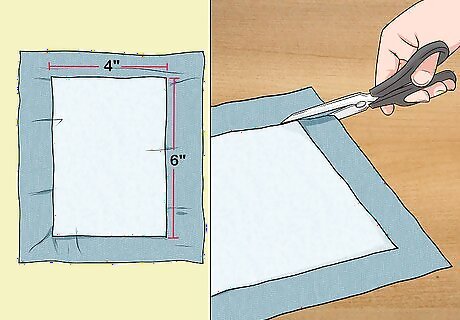
Make a pocket piece if desired. If you would like to include a pocket on the front of your overalls, then you can also make a pocket piece. To make a pocket piece, draw a rectangle onto your fabric and cut it out. Make sure that the rectangle is smaller than your front bib piece, but large enough to use as a pocket. A good pocket width might be 4” (10 cm) by 6” (15 cm). Make sure to add 1” (2.5 cm) to both sides of the rectangle for the seam allowance as well. You will only need 1 piece to create the pocket, so you only need to cut out 1 rectangle.
Sewing Your Pieces Together
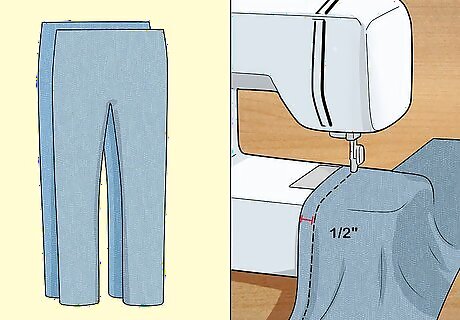
Sew your leg pieces together. If you are using a pattern, then your pattern will most likely indicate that you need to start by sewing together your leg pieces. Follow your pattern’s indications to sew the leg pieces together. If you are not using a pattern, then line up your jean cutout pieces so that the right sides of the fabric are facing each other and the edges are lined up. Then, sew along the outer edges of the legs and along the inseam. Sew about ½” (1.3 cm) from the edges of the fabric. Make sure that the right sides of the fabric are facing each other when you sew the leg pieces together. This will ensure that the seam will be hidden when you wear the overalls. Do not sew along the hip areas of the overall bottoms. You will need to add a couple of buttons here to secure your overalls. Only sew up to about 3” (7.5 cm) to 4” (10 cm) from the tops of the outer leg pieces.
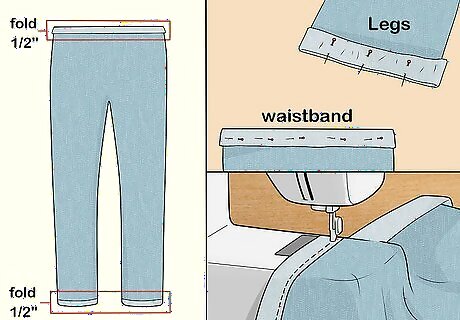
Hem the legs and waistband. After you have connected the leg pieces, you will need to hem the bottom of the legs and the waistband. Turn the overall bottoms right-side out. Then, fold over about ½” (1.3 cm) of the fabric around the legs and waistband (including the side hip panels of your overall bottoms). The wrong sides of the fabric should be facing and the raw edges of the fabric should be hidden. Pin the fabric in place and then sew along the edges to secure the hem. Remove the pins as you sew.
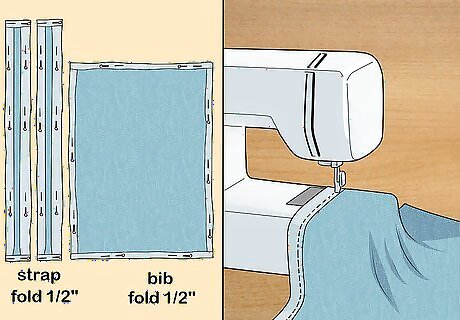
Hem the bib pieces and straps. Hem the edges of the bib pieces and straps by folding over ½” (1.3 cm) of fabric. The wrong sides should match up and the raw edges of your bib pieces should be hidden on the back side of the piece. Pin the fabric to hold it and then sew the hem in place. Remove the pins as you sew.
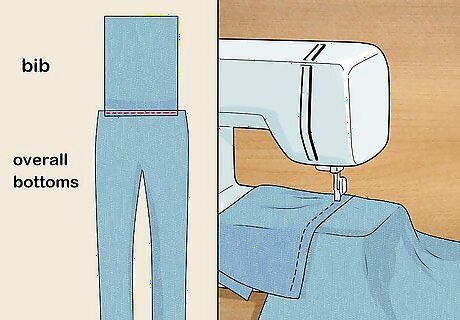
Attach the bib pieces to the overall bottoms. Next, you will need to attach the bib to the waistband of your overall bottoms. Place the short edge of the bib so that it is centered on the front of the overall bottoms. Line up the edges of the bib and overall bottoms waistband so that the right sides of the fabric are facing each other. Then, sew along the edges to secure them together. Repeat to attach the other bib piece on the back side of your overalls.
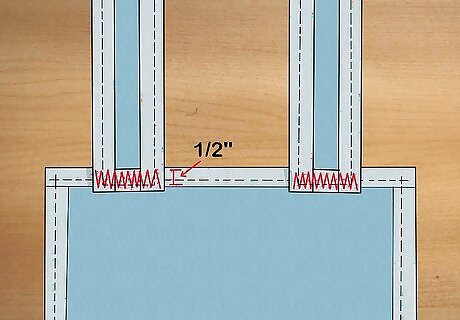
Sew the straps onto the back piece of your overalls. To attach the straps, line up the edges of the straps with the outer edges of the top of the back bib piece. Place the straps so that about ½” (1.3 cm) of the material is under the bib material. The right sides of the straps should be aligned with the wrong sides of the bib. When the pieces are lined up, sew across each of the straps twice using a zigzag stitch. This will secure the straps to the bib.
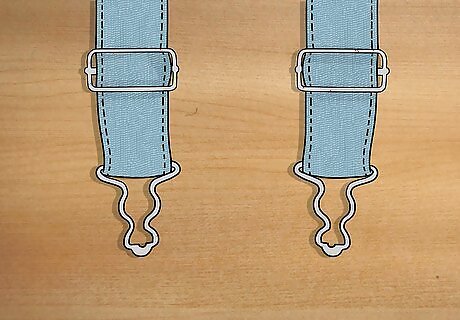
Install the hardware. To complete your overalls, you will need to install your hardware. You will attach a buckle to the free ends of your straps and top front edges of your bib, and you will need to attach 2 to three buttons on each side of your overall bottoms openings. Follow the instructions included with your hardware to attach the buttons and buckles. Hammer the button pieces together to secure them. Make sure that you line up the buttons with the button holes you have created. Slide the ends of your straps through the buckle openings and sew across the straps to secure the straps in place.
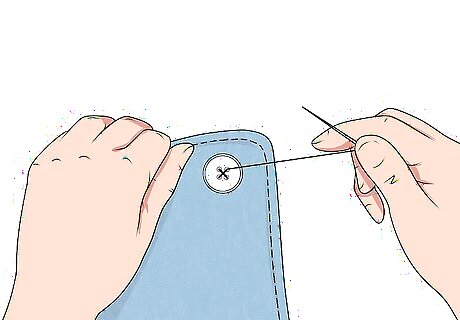
Sew on any buttons you want to use. If you are using any buttons that need to be sewn into place, then use a needle and thread to sew them in place. Thread a needle with about 18” (46 cm) of thread that matches your fabric and/or buttons. Then, tie a knot in the end of the thread. Sew in and out of the button holes and fabric to attach the button, pulling the thread taut each time you pull it through the button hole and fabric. After the button is secured, tie a knot in the end of the thread to secure it and cut the excess.
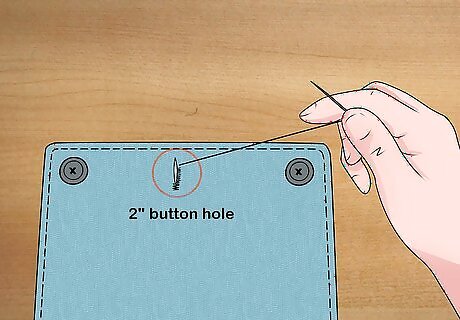
Create the button holes. You will need to cut small slits in your fabric for the button holes. Space these out by about 1” (1.3 cm) to 2” (5 cm). Seal each of the button hole strips with some fabric glue to prevent them from fraying, or use the button holer attachment on your sewing machine (if you have one) to sew along the edges of the button holes. This will prevent the button holes from fraying and tearing.














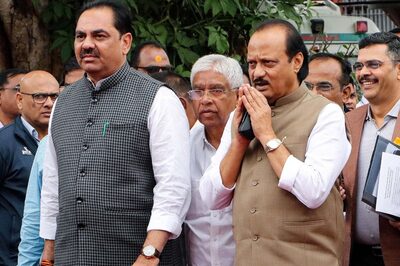
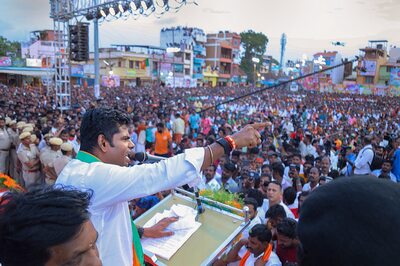
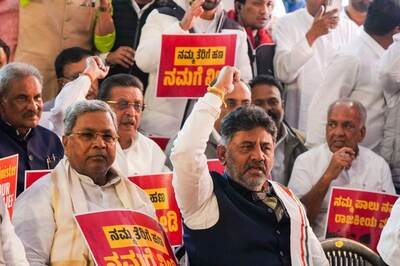
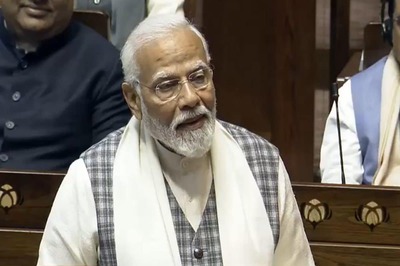


Comments
0 comment